My Chats
My chats section in the chat console lists all the active chats of the agent. The chats assigned to the logged-in agent: either picked manually from the queue, assigned by a team manager, or through an API, are displayed within the My Chats section. Suppose an agent holds on to a chat for a certain period without responding. In that case, it is automatically released back into the Queue, allowing other agents to pick it up.
Further, the new chats are represented by a green dot, and pending chats are represented by a red dot adjacent to the Chat ID. Once an agent responds to a pending chat, the red dot disappears.
Please refer to the section [Auto Move to Queue " section (https://docs.imi.chat/docs/case-settings#section-auto-move-to-queue) for further details.
Click the My Chats tab on the Chat Console page to display the chat list that is currently active.

Agent Initiated Chats
Agents can create a chat and initiate a conversation with customers on the channel of their choice or customer’s choice. Webex Engage allows agents to create a chat by providing their Customer ID. A Customer ID is a unique ID that businesses typically use to identify their customers. Webex Engage allows agents to merge all channel identifiers for a particular customer with the Customer ID.
Once the customer’s channel IDs are linked to their Customer ID, agents can create chats by providing the Customer ID. Webex Engage will automatically pull up the channel-specific identifier (Mobile Number for SMS, Facebook Page Scoped ID for Facebook Messenger, Email ID for Email, WhatsApp Number for WhatsApp, and Twitter ID for Twitter).
Note:
An agent can initiate a chat on Twitter or Facebook channels only with those customers who have sent a message through these channels at least once. The option for an agent to initiate a new chat can be controlled by the team manager. The team manager can switch this feature for a particular team to prevent the agents from initiating new chats. Please refer to the section Agent Initiated Chats under Case Settings for more information.
Follow these steps to initiate a new chat:
- Click Add icon.
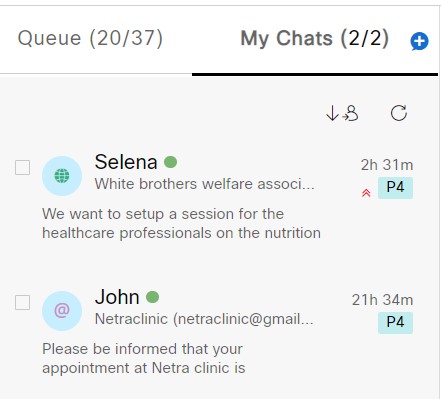
- A Chat ID is auto-populated by the system. In addition, you can provide a Chat Alias ID if needed.
- Select the channel of communication (SMS/Facebook/Twitter/Email/WhatsApp) for the customer.
- Enter the Customer ID.
- Upon entering the Customer ID, all associated channel identifiers (Mobile Numbers/Email IDs/Facebook ID/Twitter ID/WhatsApp) are populated.
- In case of SMS, Email, Facebook, Twitter, and WhatsApp channels, the system will auto-suggest the relevant asset from the available list of assets to the agents. The system also organizes the active assets on the top and grays out assets that have active chats in progress, and lists them at the bottom of the drop-down list.
Note:
When an agent hovers on a grayed-out asset in the drop-down list, an error message appears on the screen.
- In case of SMS or Email channels, the agent can provide a New Mobile Number or Email ID.
- On doing so, the agent is prompted to either
- Create a New Profile for the customer by providing a New Customer ID or
- Merge the New Mobile Number/Email ID with the existing customer profile or
- Replace an existing Mobile Number or Email ID with the new one.
Note
Please note that WhatsApp has deprecated the HSM templates. Instead of HSM, WhatsApp introduced a new message format and named it Message Templates (MTM). So, we have deprecated this feature on the Webex Engage application as well. Administrators can no longer create new HSM templates on the Webex Engage application, but we still support the ones created in earlier releases until WhatsApp supports these templates.
The following are important restrictions on HSM templates:
To initiate a conversation with a customer, WhatsApp requires you to use a pre-approved message template called a Highly Structured Message (HSM).
All the HSM Templates created on Facebook Business Manager need approval from WhatsApp.
It takes 15 days to get approval from WhatsApp.
Highly Structured Message (HSM) templates help agents to re-initiate a chat with customers who did not respond for ≥ 24 Hours.
Webex Engage HSM Template accepts only those values configured in WhatsApp Manager (Namespace, Template Name (ID), Languages, and Template Text).
Client Admin /Team Manager does not have permission to Add or Configure new language or any field in Webex Engage HSM Template.
A Tenant will provide all the HSM configurable values to Client Admin / Team Manager. The same values will be used to configure HSM templates in the Webex Engage application.
For more information on how to Add and Configure Mobile Numbers and HSM Templates in Facebook WhatsApp Manager, click on the below link:
https://developers.facebook.com/docs/whatsapp/getting-started
- The agent has the following three options here:
- Change Customer ID: Agents can create a New Chat with a New Customer ID for the Mobile Number or Email ID mentioned.
- Merge Profile: This will prompt the agent to merge the New Mobile Number or Email ID with the existing customer profile.
Note
Agents can also merge a customer’s profile across different channels by updating the Customer ID in the Customer Details section. Please refer Profile Linking section for more information.
- Replacing the Mobile Number or Email ID: This will allow the agent to replace an existing Mobile Number or Email ID of the customer with a New Mobile Number or Email ID, respectively.
Following events occur once the agent replaces the Mobile Number or Email ID:
The requested Mobile Number or Email ID is updated within a few minutes.
The earlier chat history linked to the Mobile Number or Email ID is now linked to the New Mobile Number or Email ID.
Customer details section now displays the New Mobile Number or Email ID.
The chat is not created immediately. A new chat can be created only once the details are updated on the system.
Pending Chats or Unseen Messages Count
Webex Engage displays different chat counts on the chat console for agents to easily keep track of waiting customers and respond to them instantly. An agent can view the below counts on the Chat Console:
- Count of pending chats (under their ‘My Chats’ section) that have unread messages. This number is displayed both at the Chat Console icon on the left panel and on the Browser Title Tab.
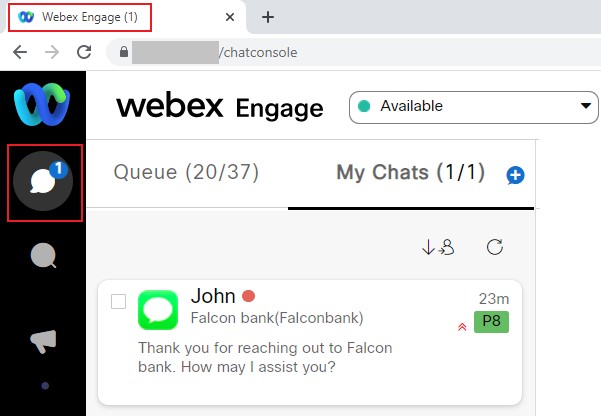
- Count of the number of unread messages on each chat (under the ‘My Chats’ section). This number is displayed against each chat in the My Chats section.
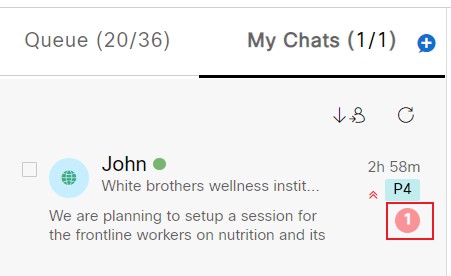
Transfer Chats
Agents can transfer chats (currently being handled by the agent) to other agents either within the same team or another team, sharing the same asset on which the chat has been created. The agents can also transfer chats to another team’s Queue.
Follow these steps to transfer chats:
- Select the checkboxes for the chats to be transferred under the My Chats section, and click Transfer Selected Chats.
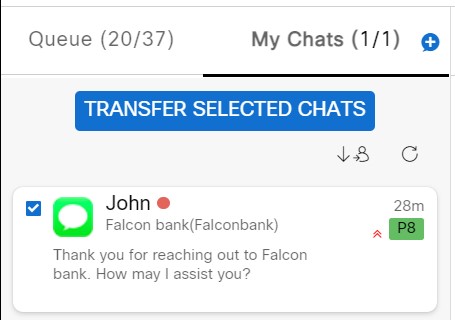
The agent can also transfer a single chat or trigger event, or trigger survey using the specified Transfer option under the Actions drop-down on the top-right corner of the conversation panel.
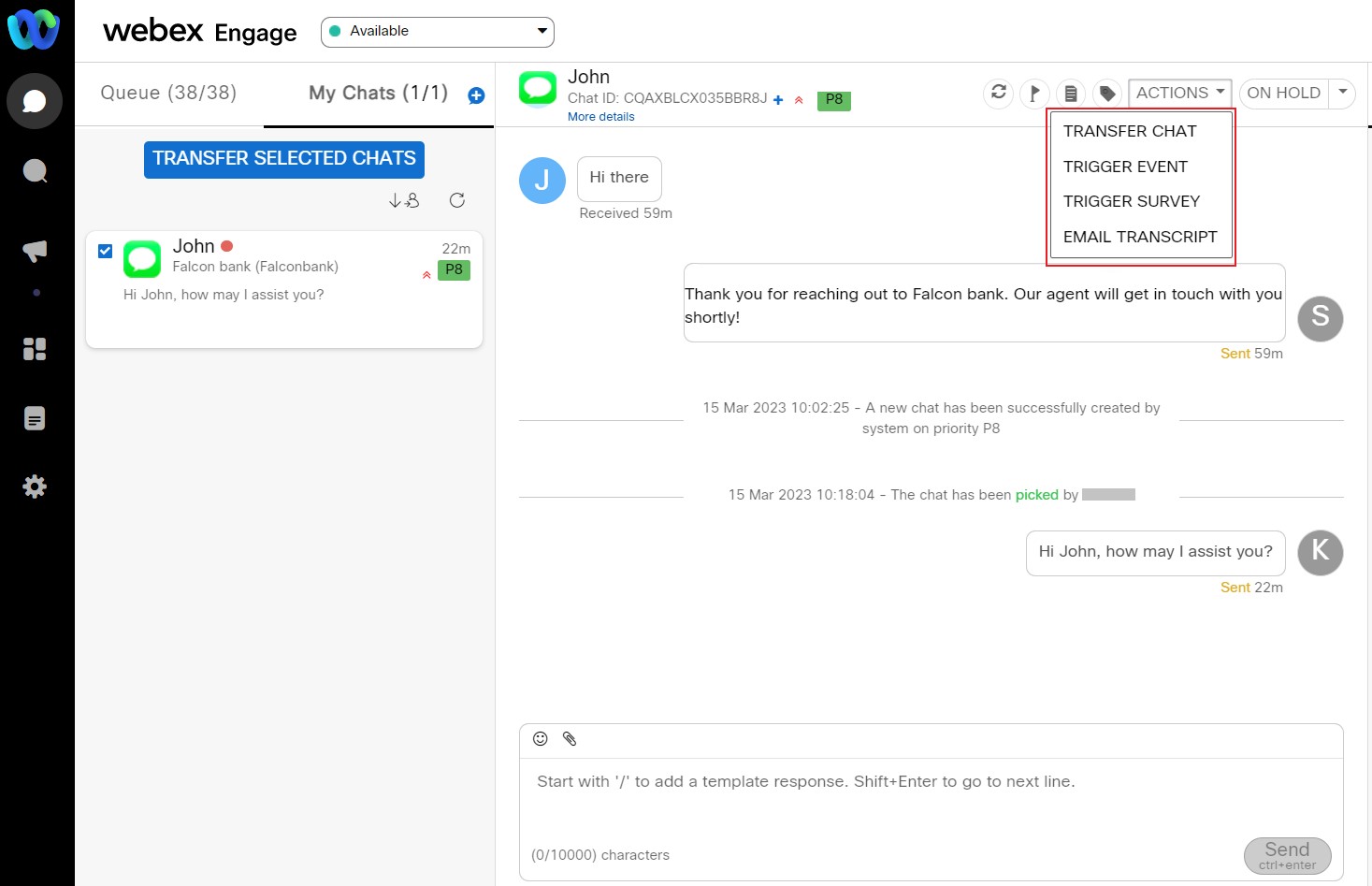
For complete information on the Transfer Chats feature, refer to the Pick/Transfer chats section in the Queue section.
Sort chats
Agents can sort the conversations in the My Chats based on the following metrics:
Default (Last assigned first): Whenever a chat is assigned or picked, the conversation will be at the top of the My Chats list.
Longest waiting first: Helps to sort the conversations basis the customer's wait time, i.e., the long awaiting customer conversations will be listed at the top of My Chats list.
Latest incoming messages: Helps to sort the conversation basis the newest message sent by the customer, i.e., the conversations with the latest incoming message will be listed at the top of My Chats list.
Highest priority first: Helps to sort the conversations basis the highest chat priority, i.e., the higher priority conversations will come on the top of the queue. The longest waiting first sorting metrics will be used to sort the conversations with the same priority if multiple conversations have the same priority. Thus, agents can prioritize between a new customer and a waiting customer.
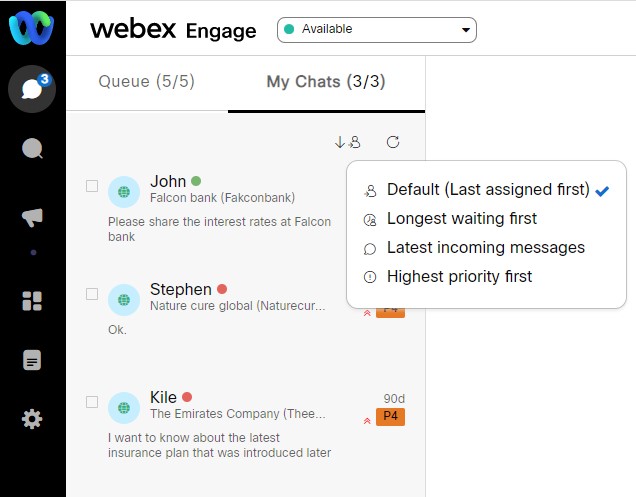
Updated almost 3 years ago
